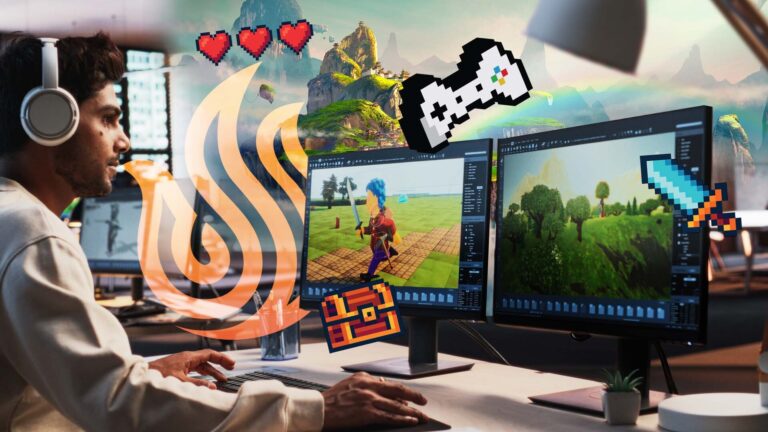In the ever-evolving world of game development, portable gaming has emerged as a dominant force. With the rise of handheld consoles like the Nintendo Switch, Steam Deck, and mobile gaming platforms, designing for portable gaming has become an essential skill for aspiring game developers. At University of Silicon Valley (USV), our game design programs equip students with the tools and knowledge to create captivating experiences tailored to these platforms.
The Rise of Portable Gaming
Portable gaming is no longer limited to simple, casual titles. With advancements in hardware and software, modern handheld devices rival traditional consoles in terms of performance and capabilities. Players now expect high-quality graphics, seamless gameplay, and engaging stories—all on the go. This shift has led to a growing demand for developers skilled in designing for portable gaming.
Key Considerations in Portable Game Design
Designing for portable gaming requires a distinct approach compared to traditional console or PC development. Here are some critical factors to consider:
1. Hardware Constraints: Portable devices often have limitations in processing power, battery life, and storage compared to their stationary counterparts. Developers must optimize their games to run smoothly without compromising quality. Techniques like efficient asset compression and streamlined coding are vital.
2. User Interface (UI) Design: The screen size of portable devices varies, and developers must ensure the UI is intuitive and accessible. Large buttons, clear fonts, and minimal clutter are crucial for enhancing player experience.
3. Gameplay Mechanics: Portable gaming sessions are often shorter, requiring gameplay that’s engaging yet concise. Levels should be designed for quick play, and progress should be easily saved. Games with pick-up-and-play mechanics thrive in this environment.
4. Multiplayer and Connectivity: Many portable devices offer online multiplayer functionality. Incorporating seamless connectivity features, such as matchmaking and cross-play, can significantly enhance the game’s appeal.
5. Control Schemes: From touch screens to physical buttons, portable gaming devices have diverse input methods. Developers must design control schemes that are intuitive and responsive, catering to various device types.
Designing for Portable Gaming: Challenges and Solutions
Challenge 1: Balancing Performance and Visuals Portable devices often have lower graphical capabilities. Developers must strike a balance between performance and aesthetics by utilizing techniques like dynamic resolution scaling and optimized textures.
Solution: At USV, students learn to use industry-standard tools like Unity and Unreal Engine to optimize game assets and ensure smooth performance on portable devices.
Challenge 2: Player Retention With shorter gaming sessions, retaining player interest can be challenging. Developers must create engaging content that keeps players coming back.
Solution: Our game design curriculum emphasizes storytelling, level design, and user engagement strategies. Students learn the art of crafting compelling narratives and addictive gameplay loops.
Challenge 3: Device Fragmentation The variety of portable devices means developers must account for differences in screen sizes, resolutions, and hardware capabilities.
Solution: USV’s programs teach students how to design adaptable and scalable games, ensuring compatibility across multiple platforms.
Trends in Portable Game Design
As technology continues to evolve, so do the trends in portable gaming. Here are some exciting developments shaping the industry:
1. Cloud Gaming Integration: With services like Xbox Cloud Gaming and NVIDIA GeForce NOW, players can stream high-quality games on their portable devices without hardware limitations. Developers are exploring new ways to leverage cloud technology to enhance gaming experiences.
2. Augmented Reality (AR): Games like Pokémon GO have showcased the potential of AR in portable gaming. Incorporating AR elements can provide immersive, location-based gameplay.
3. Accessibility Features: Portable gaming is becoming more inclusive, with developers adding features like customizable controls, text-to-speech, and scalable difficulty levels to cater to a broader audience.
4. Cross-Platform Play: Enabling players to connect across devices fosters community engagement and extends a game’s lifecycle. This feature has become a staple in modern portable gaming design.
5. Monetization Strategies: Monetization is critical in portable gaming. Developers are exploring new approaches such as subscription models, in-app purchases, and ad-based revenue systems to sustain their creations while ensuring player satisfaction.
6. Sustainability and Energy Efficiency: As awareness grows about environmental impacts, developers are considering energy-efficient coding practices and sustainable designs to minimize battery drain and resource usage.
Designing for Portable Gaming: A Student Perspective
At USV, students in the game design program take a hands-on approach to designing for portable gaming. From creating prototypes for handheld consoles to developing mobile games optimized for touch interfaces, students experience every aspect of portable game development. Collaborations with peers and faculty ensure they receive feedback from diverse perspectives, mimicking industry environments.
Our program also emphasizes the importance of staying updated with industry trends. Students regularly analyze successful portable games, participate in workshops, and engage with industry professionals to gain insights into the evolving landscape of game design.
Why Study Game Design at USV?
University of Silicon Valley works to be at the forefront of game design. Our game design programs offer:
- Comprehensive Curriculum: Covering everything from fundamental design principles to advanced development techniques.
- Industry Tools: Students work with industry-standard software and hardware to create professional-quality projects.
- Real-World Experience: Our programs include opportunities for internships and collaborative projects with leading game companies.
- Supportive Community: A network of peers, faculty, and alumni dedicated to helping students succeed.
Whether you’re passionate about handheld consoles, mobile gaming, or emerging technologies, USV provides the resources and expertise to help you excel in designing for portable gaming.
Broader Impacts of Portable Game Design
Portable gaming has reshaped how people interact with games, allowing them to play wherever and whenever they want. This accessibility has made gaming more inclusive, reaching audiences who may not have access to traditional consoles or gaming PCs. Additionally, portable gaming fosters innovation, pushing developers to rethink traditional design paradigms and adapt to new challenges. At USV, students are not just learning to create games—they are preparing to shape the future of the industry.
Learn More
Are you ready to take the next step in your game design journey? Explore our Game Design & Development program and discover how you can turn your passion for gaming into a rewarding career. At USV, we’re not just teaching game design—we’re shaping the future of the industry.


